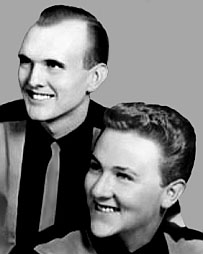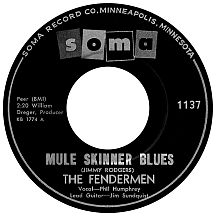THE FENDERMEN
Mule Skinner Blues
'Good morning, Captain!'...thus begins "Blue Yodel No. 8," one of the signature tunes of Jimmie Rodgers' classic repertoire as well as the liberty-taking remake by upper midwest derring-duo The Fendermen in its retitled state, "Mule Skinner Blues." Asheville, North Carolina served as Rodgers' stomping grounds in the late 1920s, his all-too-brief recording career cut short by his death in 1933 at age 35 from tuberculosis-related complications. The original "Blue Yodel" on Victor, later known more commonly as "T for Texas," was a million seller in 1928 and made a star of the former railroad worker ("The Singing Brakeman" was one of several nicknames), leading to many more "Blue Yodel" songs (each of them numbered, all the way to unlucky 13), though each was a unique piece of music connected by his inimitable yodeling style.
The eighth go-around for "Blue Yodel," in 1930, seemed ripe for revival three decades later. Jim Sundquist, from the small north Wisconsin town of Niagara, and Phil Humphrey of the state's capital, Madison, shared the same birthday (November 26, 1937) and a preference in guitars (Fender), ultimately naming their two-man act after the brand name. They met briefly in 1957 while attending college in Milwaukee, crossing paths again several months later when Phil converted Jim from previous six-stringed axes to the wonders of Fender's Telecasters and Stratocasters. They began playing small clubs in and around Madison, just the two with no other backing: Phil the lead singer and rhythm player, Jim the lead guitarist.
Their sets were made up mainly of the era's rock and country hits, but when they cut loose with "Mule Skinner Blues," bar patrons were up on their feet digging those gone cats! Where Rodgers' original ('...do you need another mule skinner...out on your new mud run...') broke into a yodel, Humphrey ad-libbed 'ha-ha' and 'yuk-yuk' silliness to what can be described as a satirical yodeling technique. A novelty by 1959 rock and roll standards, it sounds more like a lunatic rant beside the Rodgers original. After bringing down the house at a bar in Milwaukee, they met record store owner William Dreger, who put up funds for them to make a record of the song (the session was in his basement), released regionally by Cuca Records of Sauk City, Wisconsin, a label that had initially specialized in polka music. "Janice," titled after Jim's wife, began a pattern of instrumental flip sides.
Though clubgoers were enthusiastic about "Mule Skinner Blues," deejays in the area didn't seem interested...that is, until Lindy Shannon, a longtime personality at WKBH in La Crosse, Wisconsin (born and raised there and apparently in no hurry to leave) began spinning the single. Brothers Amos and Dan Heilicher of Soma Records in Minneapolis, a company that had raised its profile a few notches when Bobby Vee and the Shadows scored with "Suzie Baby" earlier in the year, picked up the rights from Cuca and had the guys redo "Skinner Blues" at the Kay Bank studio, polishing it up a bit without losing its over-the-top appeal (or 'Cha-cha-cha' ending). A new instrumental flip side, "Torture," rocked consistent with its title on the Soma single. All Fendermen recordings, with or without vocals, were done with the dual guitar sound...and that's it!

The single hit the national charts in the spring of 1960. In mid-May, Phil and Jim opened for Johnny Cash, Johnny Horton and C&W queen Kitty Wells at the Minneapolis Auditorium. In mid-June, as the single was climbing the top 40, they appeared on Dick Clark's Saturday Night Beech-Nut Show. Then "Mule Skinner Blues" spent all of July in the top ten. A well-produced Mercury Records cover by Rusty Draper hit the charts briefly but lacked the humor, and the rockabilly feel, that Phil and Jim had laid down. A follow-up Fendermen 45 came on the heels of the hit; "Don't You Just Know It" had been part of their live act for some time, a logical choice as the 1958 Huey (Piano) Smith and the Clowns hit, with its 'ha-ha-ha-ha' refrain, fit right in with Humphrey's vocal style ("Beach Party," a midtempo instrumental shuffler, stayed true to the B side formula). But lightning didn't strike twice and the single rose no higher than "Bubbling Under" territory.
Bassist Denny Dale and drummer Johnny Hauer were added to the act for live shows. A third Soma single, "Heartbreakin' Special," penned by Humphrey but derived from a long line of folk songs about trains ('...bringin' my baby back...'), didn't catch on at all. "Can't You Wait," written by Dorsey Burnette, was the first non-instro, non-yodeling, not-the-least-bit-deranged flip side. A lesser act as far as the east and west coasts go, the Fendermen were big stars in the midwest, traveling and performing extensively throughout its wide range in 1960 and '61. But it didn't last long; legal wrangling between Cuca and Soma made a mess of things and the two guitarists chose to go their separate ways.
Phil Humphrey performed for a few years under the Fendermen name. Jim Sundquist made a couple of records for Cuca, "Molly and Ten Brooks" as Jimmy Sun and the Radiants and "Rockpile" under the name Jimmy Sunn. He headed up a group called The Muleskinners on a strong late-'64 double-sider, "Wolfman" and "Everglades." Since 1960, Jimmie Rodgers' classic "Blue Yodel No. 8" has been referred to as "Mule Skinner Blues" by just about everyone; Dolly Parton put her own stamp on the song and it became her first top ten country hit in 1970. Still, it's the 'yuk-yuk'-in' version by The Fendermen that's most fondly remembered.


